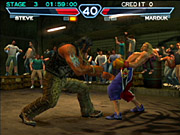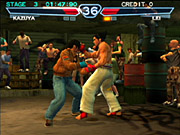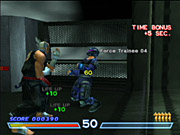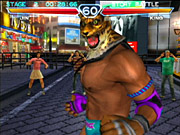When the PlayStation 2 launched in late 2000, Tekken Tag Tournament was one of the best games in the system's starting lineup. Actually, it's remained one of the finest fighting games for the system ever since, though given that fighting games are pretty scarce these days, maybe that isn't saying much. At any rate, Namco has dominated the 3D-fighting genre for years, between its Tekken games and Soul Calibur. So perhaps it's no great surprise that the company didn't exactly aim for the moon with its latest offering, Tekken 4.

Released months ago for Japanese PS2 owners and more than a year ago in arcades, Tekken 4 really isn't much different from Tekken Tag Tournament before it, which itself was very similar to 1997's Tekken 3. That's both the bad news and the good news: The similarities between this and previous Tekkens are obvious, but the changes are appreciable (though arguably not all for the best) and the new characters are cool. Beyond that, Tekken 4, like its predecessors, is an ideal fighting game both for those who've been playing fighting games for years, as well as for those who've never played a fighting game before. No, you couldn't call it ambitious. But you could still call it one of the better fighting games in years.
Tekken 4 offers a standard assortment of gameplay modes, all of which revolve around pitting two skilled martial artists against each other in elimination matches. You've got arcade, time attack, and survival mode where you'll fight progressively tougher computer opponents; versus mode for taking on a friend; training and practice mode for trying out all of your fighter's moves; and team battle mode where you can choose multiple fighters and you have to defeat opposing team members one at a time. However, the main attraction is the "story battle," which is basically a prettied-up arcade mode that gives each character a storyboard-style intro and epilogue, as well as a prerendered ending cutscene. It's nice that Namco put some effort into fleshing out each character's story, though none of the stories really figure into the gameplay--you'll still just take on one opponent after another, regardless of which character you chose. At any rate, that same effort would have probably been better spent on granting gamers the option to play Tekken 4 online, a feature that would have made Tekken 4 for the PS2 truly amazing.
Some previous home versions of Tekken games have included additional unlockable hidden modes, but not Tekken 4. The only extra worth noting is available right off the bat: Tekken Force, basically a side-scrolling beat-'em-up like Final Fight. The PlayStation version of Tekken 3 actually had a similar mode, though it's handled better here and makes for a good diversion as you take on droves of enemy grunts at a time. You'll be impressed at how the game manages to dump so many characters onscreen without compromising the silky-smooth frame rate.
Tekken 4 has fewer selectable characters overall than Tekken Tag Tournament, but Namco merely sought to remove the ones that had many identical fighting moves. The resulting game has nearly 20 distinctly different fighters, each with around 100 different moves. The majority of these will be familiar to series fans: guys like the burly American martial artist Paul Phoenix, the leopard-masked pro wrestler King, and the Bruce Lee look-alike Marshall Law; gals like the sprightly Ling Xiaoyu and the coldhearted assassin Nina Williams; and weirdos like the alien ninja Yoshimitsu and the kung fu-fighting bear Kuma. Of course, the most dysfunctional family in fighting games, old man Heihachi and his bitter son Kazuya Mishima, returns, as well as Kazuya's troubled son Jin, who boasts an almost entirely new set of moves. Most of the other returning fighters all look different than before yet have many of their old moves, though a number of useful new ones too.
The newcomers to Tekken 4 include British middleweight boxer Steve Fox, the huge vale tudo fighter Craig Marduk, and the buxom Brazilian capoeirista, Christie Monteiro. Christie is for the most part just an attractive female replacement for Tekken 3's Eddy Gordo, though Marduk and Steve are completely original. Steve is particularly interesting because he can use a wide variety of dodges and feints, in place of kicks.

By and large, though, this latest Tekken plays just like all its predecessors. The four face buttons on the DualShock 2 correspond to your fighter's four limbs, letting you execute left and right punches and kicks with perfect responsiveness and in various combinations. Most Tekken moves are accomplished simply by pushing these buttons in certain combinations or in certain sequences, sometimes while tapping the D-pad in a certain direction. Yet while relatively few moves in Tekken 4 are difficult to execute, remembering them all and knowing how best to use them will take a lot of time and practice. Then again, if you already practiced all that in Tekken 3 or Tekken Tag Tournament, then you'll be able to get into Tekken 4 effortlessly.
Still, it won't be long before you notice some of the new gameplay features, which you can also learn about in the game's hefty 40-page manual. Most notably, Tekken 4 is the first game in the series to take place in closed arenas of different shapes and sizes--all of its predecessors took place on infinitely wide stages. So now you can bash your opponents against walls, setting them up for devastating combos. And if you find your own back against a wall, fortunately you can execute a quick recovery move to roll to the side, putting yourself out of harm's way. Also, while previous Tekken games allowed each character to execute two different standard throws when you pushed either the left punch and kick or right punch and kick buttons simultaneously, in Tekken 4, each character can execute a position change move when you press the left punch and kick buttons, which does no damage but forces the opponent behind you. The best use of this move is for turning the tables on the opponent when you're cornered. Furthermore, Tekken 4 characters can all parry low attacks much like in Tekken Tag Tournament, something that only a relative few characters could do in previous games, and it's seemingly a generous addition to the standard arsenal.
Strangely enough, many of Tekken 4's new gameplay features are similar to those added to the third installment of Sega's rival 3D fighting series, Virtua Fighter--and just as Virtua Fighter 3 was much maligned by arcade gamers for its inclusion of walled arenas and uneven surfaces, as well as the addition of more evasive maneuvers, so was Tekken 4. The stages that force you to fight on inclined surfaces are the awkward ones. Counterintuitively, the character on higher ground tends to be at a severe disadvantage, since he or she ends up being particularly vulnerable to getting knocked into midair and then juggled by successive hits for massive damage. And the addition of walled arenas is neither innovative nor particularly welcome--the walls are just invitations for overly punishing combos. Tekken 4 added these features but just doesn't implement them particularly well. These aspects of the game seem tacked on and somewhat unpolished--and actually, that's exactly what they are.

The core action is still great. You'll need to mix up high, middle, and low attacks, lateral dodges, counter hits, reversals, parries, and throws in order to succeed. There's an elaborate, three-dimensional rock-paper-scissors scheme at work in the gameplay, and it represents the ultimate refinement of all that fighting games have amounted to since Street Fighter II more or less invented the genre in 1991. Some experienced Tekken players argue that Tekken 4 isn't well balanced--that some characters have moves that are overly effective, allowing less-experienced players to sometimes unfairly defeat experts. But the last few Tekken games have largely been the same way. It's a real testament to Namco's designers that the Tekken games offer characters that play as different as they look--some can be pretty effective if all you do is mash on the buttons, while others demand precision, tactics, and foresight. At any rate, while Tekken 4's debatable balance issues may have caused dissention among players at the arcades, they're not nearly as relevant when you're playing at home. Meanwhile, the game's depth lies just beneath its superficial accessibility and can be attested to by the existence of numerous long-winded, insightful player-written FAQs devoted to each of the game's characters.
Debates over which character is strongest might rage on, but there can be no denying that Tekken 4 looks terrific. Granted, it looked even more impressive when it was first released for the PS2 in Japan six months ago, but it's still one of the best-looking PS2 games out there. The detailed, stylized, and fully articulated character models sport realistic clothing and facial expressions and feature tons of amazingly motion-captured fighting moves, albeit many animations are straight from previous Tekken games. The new 3D arenas are much more detailed than any seen before in a Tekken game, and some of the highlights include a Fight Club-style fighting ring formed by walls of cheering spectators and a spooky high-tech facility covered in low-hanging fog. Some of them, such as a shopping mall and an airport, are a bit too sparsely populated, and some have breakable objects in the area that look pretty fake when they fall apart, and these fail to impress. Also, despite the detail found in all the characters, you rarely get a good close-up of any of them, which is a bit of a shame. Still, Tekken 4 looks really, really good and better in many ways than the PS2's other big 3D fighting game, Virtua Fighter 4. Of note, Tekken 4 supports progressive scan displays, which will make the game look its absolute best.
Tekken 4's sound is predictable--every Tekken game since 1995 has sounded pretty much the same, and this one is no exception. Punches, kicks, and blocks, as well as some of the voice samples are all recycled from previous games, which is unfortunate since Tekken dates way back to 1994. On the other hand, for the first time in the series, some of the fighters have actual speaking lines, which they deliver reasonably well, and this does a lot for their personalities. Thankfully, Japanese characters like the Mishimas speak in their native language (with subtitles for your convenience), and the game's soft-spoken narrator also does a good job. The game's soundtrack is more varied than the droning techno of previous installments, and while that's good in itself, most of the music still isn't all that special and drones harmlessly in the background.

The presence of about 20 distinctly different characters on the roster means you could easily spend a ton of time playing Tekken 4 either against friends or against the competent, scalable computer AI. True, if you've mastered the last couple of games, you'll be able to figure out the subtleties of this one pretty quickly. And if you've already played a ton of Tekken in the past, then maybe all this won't seem new enough to you.
But that's not the fault of Tekken 4 so much as it's the fault of the fighting game genre, in general. Even this year's superlative Virtua Fighter 4 for the PlayStation 2 doesn't really break the mold of what the genre's been like for years. So if you're sick of fighting games, or have never really cared for them to begin with, then don't expect Tekken 4 to do wonders for you. And even if you do love fighting games, and the Tekken series in particular, you'll still probably agree that the series is past its prime with Tekken 4. It's not as technically impressive of a game as some of its predecessors, it doesn't have as many extras or as many new moves, and some of the additions to the gameplay are questionable. But that's because there's really not a whole lot more that can be done with the formula such as it is. So make no mistake: You'll get what you pay for with Tekken 4--an extremely solid, long-lasting, accessible, and fun-to-play fighting game that comes from one of the world's best developers of the genre.